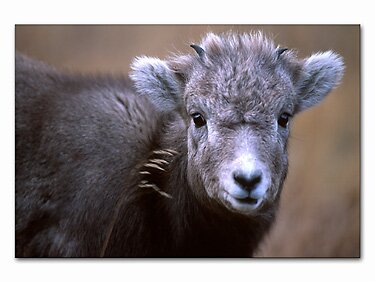

All Images And Text On This Site Are Copyright 1999-2001
by
Thomas D. Hill Jr.
| ABOUT KEIKO |
| WHAT'S NEW |
| THE KEIKO GALLERY |
| EQUIPMENT |
| IMAGE OF THE MONTH |
| ARTICLE OF THE MONTH |

3 March 01
I love taking pictures of Big Horn Sheep. Maybe it's related to their outstanding accessibility in Jasper NP, which is one of my all time favorite locations to shoot large mammals. Or, maybe it's related to their wonderful social activities. Maybe it's just because they're really photogenic. Never the less, I've made hundreds of images with them as my subject. Every single time I go out, it's a new adventure. I never know what I'll find or what I can make.
This guy was browsing along the side of the road in Jasper NP. As always, Big Horn Sheep aren't shy and this guy was no exception. Unlike other times of the year, where males and females are in separate groups, the fall is particularly interesting because both groups are together for the rut. From the end of October until end of November, the mating season is full on. The rams spend their time figuring out who's on top and chasing the ewe's around. Most of the time, the ewe's are running away because they're either not ready for mating or the potential suitor didn't pass some requirement or test. Most of the time, the kids or yearlings are totally oblivious to all the activity. Unless they happen to be in the way of a chase between ram and ewe, the youngsters pretty much ignore what the adults are doing. The youngsters are spending their days getting ready for their first winters. Every moment of the day is spent eating and browsing and making sure they aren't being left behind by their mothers and aunts.
This guy was working his way long the road to Jasper Town site with the rest of his herd. The rut was almost over--that is to say the rams weren't beating heads anymore--but both males and females were hanging out together. Usually I'd just determine which way the herd was flowing, then position myself down the road long their path. Without fail, the herd would approach and divide to each side of me as they made their way along the fields browsing. Sometimes, I'd get noticed but most of the time they totally ignored me. About the only way they'd take notice of me was if I moved suddenly. They seemed to be unconcerned about unusual sounds like whistles and such. I guess it comes from thousands of photographers trying to get there attention by whistling. Occasionally as they'd make their way by, one or two in the herd would raise their head to see what I was up to. They'd still be munching away on some grass or other browse but mostly this little diversion of the regimen of eating would be my only opportunity to make interesting images. Head comes up, snap the image, head goes back down. Not tremendously exciting but when it works, it's wonderful.
I shot this image using Fuji Velvia. The colors contrast with most of my other wildlife images because I shoot Provia F most of the time. Occasionally, the light is right--bright and not too harsh--to allow me to use Velvia. Most of the time I use Velvia of landscape photography but unfortunately it's too slow for most wildlife situations and when pushed it becomes almost uncontrollably contrasty. Not a great combination. On the plus side, which is why I wish it was better, is the color palette is outstanding. No question the color range isn't too garish like Kodak E100Vs can be or too bland like Provia F is. It has just enough saturation to make the images standout. But, it's hard to use so I have to make the most of the opportunities when they arise. Probably the only critique I have about this image is the DOF is a bit small. It would've been better if more of the nose was in focus. Oh well... The problems with using such a slow film.
Cheers,
Tom